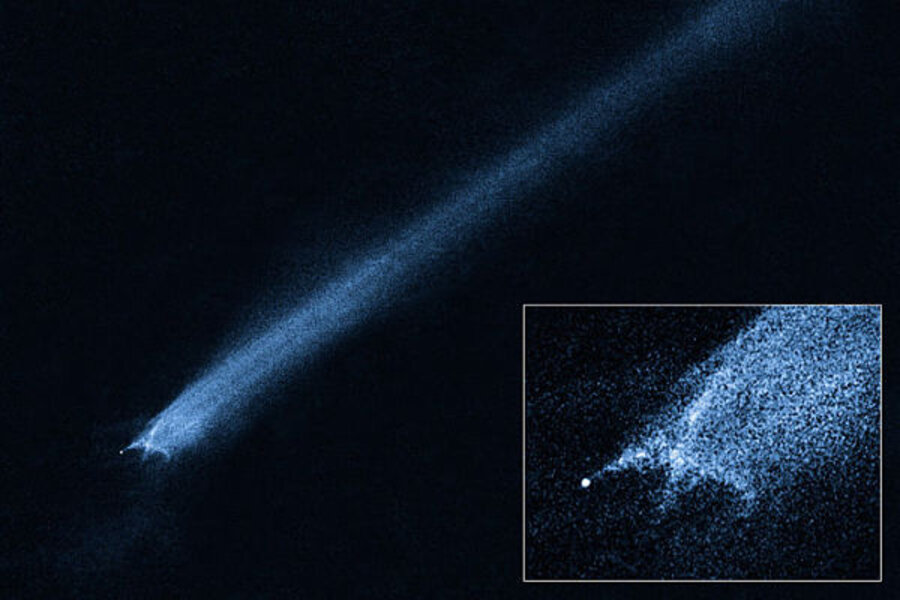Has the Hubble Space Telescope spied asteroid-on-asteroid collision debris?
Loading...
Astronomers appear to have offered iron-clad proof that two asteroids cannot occupy the same spot simultaneously.
That was never really in doubt, of course. But when you can grab an image of what appears to be fresh collision debris, it makes for an "oh, wow" moment.
Astronomer David Jewitt enlisted the help of the Hubble Space Telescope to observe the apparent collision debris -- a feature first detected in early January by the Lincoln Near-Earth Asteroid Research effort. (The US Air Force foots the bill for LINEAR, which is operated by MIT's Lincoln Laboratory in Lexington, Mass.) If Dr. Jewitt's interpretation holds up, it represents the first time astronomers have seen such a collision, or at least the recent aftermath of a collision.
The aftermath of ancient collisions? You can see it on very dark evenings in a feature called zodiacal light. The sun's rays bounce of space dust that appears along the orbital plane of the solar system's planets and contains tiny fragments from comets and from asteroid collisions. (For classic-rock fans, Queen lead guitarist Brian May finally got his PhD in astrophysics in 2007 on the strength of his studies of zodiacal dust.)
The new feature, dubbed P/2010 A2, looks a lot like a comet's tail, acknowledges Jewitt, a researcher at the University of California at Los Angeles. But it displays striking differences as well.
In effect, it's a headless tail -- it has no relatively uniform halo, or "coma," of dust at the leading end. The remains of the one of the asteroids -- now a kind of nucleus -- appears outside the halo, rather than inside. And spectroscopic studies using ground-based telescopes reveal no gases. Comets, on the other hand, spew copious amounts of gas as they approach the sun and the ices they contain turn from ice to a gas in a flash (do not pass liquid phase, do not collect $200).
Finally, Jewitt points out, the feature is orbiting the sun just inside the inner boundary of the main asteroid belt, between Mars and Jupiter.
Such collisions are very rare events within the life span of an astronomer. But over longer time spans? The two victims of this collision are believed to belong to a family of asteroids, touchingly named the Flora family. Astronomers trace this group's origin to a larger collision some 100 million years ago.
For all the asteroid belts sci-fi movies serve up -- densely packed obstacle courses that white-knuckled rocket jockeys try to negotiate -- our solar system's main asteroid belt is so diaphanous that you have to intentionally aim a spacecraft at one to stand a high chance of hitting it.
A little math with some very crude assumptions -- like a perfectly flat asteroid belt, and an even distribution of asteroids, among others -- helps make the point (bear with me here). By some estimates, there are some 1.7 million objects in the asteroid belt at least 1 kilometer (0.62 miles) across. So let's just go for the big ones.
The highest concentration of asteroids falls within a swath of space ranging from 2.1 and 3.3 astronomical units (AU) from the sun. So that band comprises an area of roughly 20 square AU. One AU, the average distance between the Earth and sun, is about 93,000,000 miles. Take the math all the way to the end, and you get one asteroid in that size class for every 102 billion square miles -- or only one kilometer-plus-sized rock for every imaginary box nearly 320,000 miles on a side.
Lots of room to miss.





